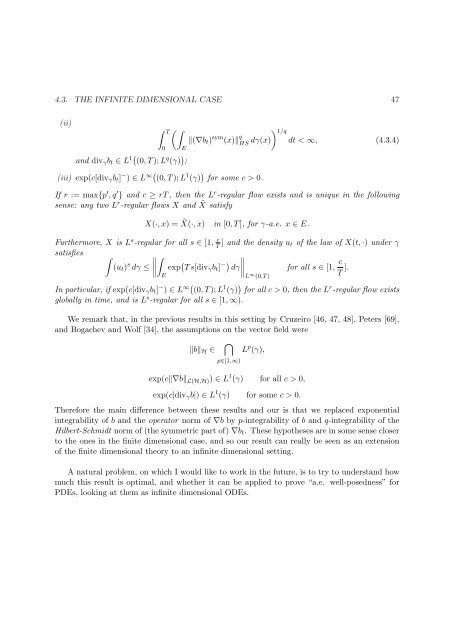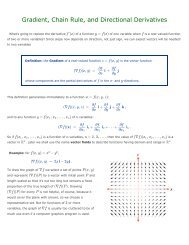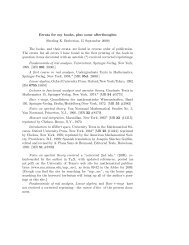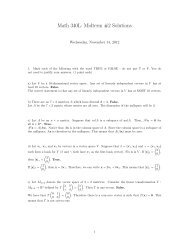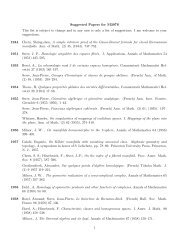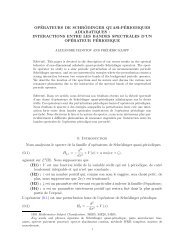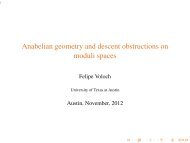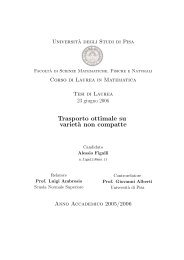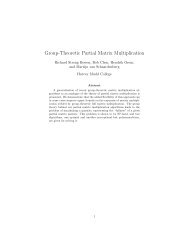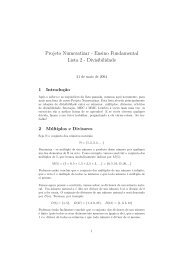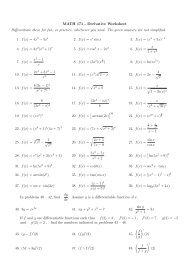Optimal transport, Euler equations, Mather and DiPerna-Lions theories
Optimal transport, Euler equations, Mather and DiPerna-Lions theories
Optimal transport, Euler equations, Mather and DiPerna-Lions theories
You also want an ePaper? Increase the reach of your titles
YUMPU automatically turns print PDFs into web optimized ePapers that Google loves.
4.3. THE INFINITE DIMENSIONAL CASE 47<br />
(ii)<br />
T<br />
0<br />
<br />
<strong>and</strong> divγbt ∈ L 1 (0, T ); L q (γ) ;<br />
(iii) exp(c[divγbt] − ) ∈ L ∞ (0, T ); L 1 (γ) for some c > 0.<br />
E<br />
(∇bt) sym (x) q<br />
HS dγ(x)<br />
1/q dt < ∞, (4.3.4)<br />
If r := max{p ′ , q ′ } <strong>and</strong> c ≥ rT , then the L r -regular flow exists <strong>and</strong> is unique in the following<br />
sense: any two L r -regular flows X <strong>and</strong> ˜ X satisfy<br />
X(·, x) = ˜ X(·, x) in [0, T ], for γ-a.e. x ∈ E.<br />
Furthermore, X is L s -regular for all s ∈ [1, c<br />
T ] <strong>and</strong> the density ut of the law of X(t, ·) under γ<br />
satisfies <br />
(ut) s <br />
<br />
dγ ≤ <br />
<br />
E<br />
exp T s[divγbt] − <br />
<br />
dγ<br />
L ∞ (0,T )<br />
for all s ∈ [1, c<br />
T ].<br />
In particular, if exp(c[divγbt] − ) ∈ L ∞ (0, T ); L 1 (γ) for all c > 0, then the L r -regular flow exists<br />
globally in time, <strong>and</strong> is L s -regular for all s ∈ [1, ∞).<br />
We remark that, in the previous results in this setting by Cruzeiro [46, 47, 48], Peters [69],<br />
<strong>and</strong> Bogachev <strong>and</strong> Wolf [34], the assumptions on the vector field were<br />
bH ∈ <br />
L p (γ),<br />
p∈[1,∞)<br />
exp(c∇b L(H,H)) ∈ L 1 (γ) for all c > 0,<br />
exp(c|divγb|) ∈ L 1 (γ) for some c > 0.<br />
Therefore the main difference between these results <strong>and</strong> our is that we replaced exponential<br />
integrability of b <strong>and</strong> the operator norm of ∇b by p-integrability of b <strong>and</strong> q-integrability of the<br />
Hilbert-Schmidt norm of (the symmetric part of) ∇bt. These hypotheses are in some sense closer<br />
to the ones in the finite dimensional case, <strong>and</strong> so our result can really be seen as an extension<br />
of the finite dimensional theory to an infinite dimensional setting.<br />
A natural problem, on which I would like to work in the future, is to try to underst<strong>and</strong> how<br />
much this result is optimal, <strong>and</strong> whether it can be applied to prove “a.e. well-posedness” for<br />
PDEs, looking at them as infinite dimensional ODEs.


